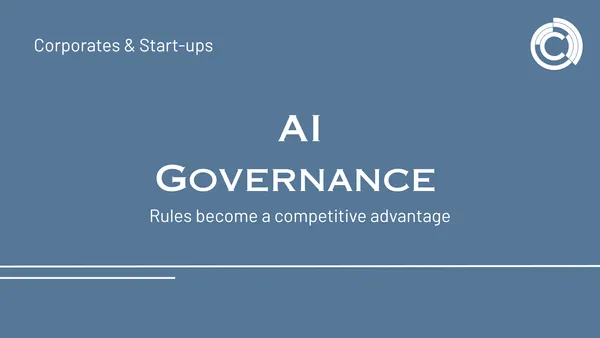
CCNet
Sep 12, 2025 • 2 min read

AI governance – rules become a competitive advantage
The use of artificial intelligence not only brings opportunities, it also harbors risks. Issues such as data protection, transparency, and responsibility are concerns for companies worldwide. By 2025, it will become clear that AI governance, i.e., clear rules and structures for dealing with AI, will evolve from a mandatory requirement to a strategic opportunity. Companies that act early will gain a competitive edge—and, in addition to fulfilling their regulatory obligations, will also build trust among customers and employees.
Contact us for more information
Why governance is necessary
AI systems can make decisions that have far-reaching consequences, from customer service and lending to medical diagnoses. Without clear guidelines, there is a risk of:
• Wrong decisions due to faulty models or data quality,
• Reputational damage due to non-transparent processes,
• Legal risks due to non-compliance with regulations such as the EU AI Act.
Governance is therefore not a stumbling block, but rather a management tool.
From cost factor to competitive advantage
For a long time, compliance was considered a necessary obligation. But in the field of AI, the perspective is changing. Companies that establish clear rules benefit in several ways:
• Trust: Customers are more likely to choose providers who use AI responsibly.
• Reputation: Early governance protects against data leaks and scandals.
• Efficiency: Clear structures accelerate the introduction of new technologies.
AI governance is thus becoming a differentiating factor, similar to sustainability or data protection in recent years.
Building blocks of successful AI governance
An effective governance strategy encompasses several levels:
• Guidelines and ethics – Define which principles apply to the use of AI.
• Transparency obligation – Document how models are trained and used.
• Risk management – Assess the potential impact of AI decisions.
• Control mechanisms – Ensure that humans can intervene at any time.
• Training – Employees must understand the risks and opportunities.
Practical implementation
Companies that successfully implement AI governance often work with **interdisciplinary teams. ** Lawyers, IT specialists, technology experts, and management work together to develop rules that both comply with the legal framework and reflect corporate values.
One practical approach is the concept of “ethics by design”: AI systems are designed not only for efficiency, but also for fairness, transparency, and security from the outset.
Global differences
While Europe is focusing on binding rules with the EU AI Act, the US and Asia often pursue more market-oriented approaches. For internationally active companies, this means that AI governance must be globally compatible. Those who establish clear standards at an early stage can respond more flexibly to different markets.
Conclusion: Governance as a strategy for success
AI governance is more than a regulatory obligation—it is a strategic tool for competitive advantage. Companies that take responsibility and create transparency secure trust, reputation, and efficiency gains.
For management, this means acting now, not waiting. Because governance is not an obstacle to innovation—on the contrary, it is the key to using AI safely, responsibly, and successfully.
FAQ about AI Trends 2025
Contact us for more information. Why is governance so important in the context of AI?
Because AI decisions can have far-reaching consequences.
What are the benefits of governance for companies?
Trust, reputation, and more efficient introduction of new technologies.
What are the core components of a governance strategy?
Guidelines, transparency, risk management, control, and training.
How does governance differ internationally?
Europe focuses on regulation, while the US and Asia are more market-oriented.
What does “ethics by design” mean?
AI systems are designed for fairness and security from the outset.